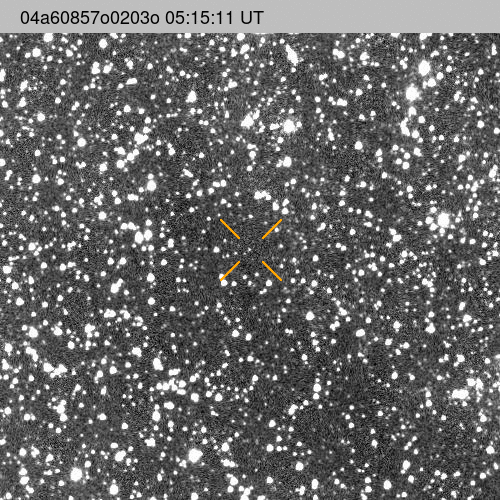A Rare Interstellar Object Is Blazing Through Our Solar System, Marking Only the Third Cosmic Visitor on Record
The comet follows just two other deep space objects documented by astronomers in 2017 and 2019

Astronomers have confirmed the third interstellar object on record is dashing through our solar system. Dubbed 3I/ATLAS, it appears to be a comet and is thought to have flown in from the direction of the constellation Sagittarius, where the central region of the Milky Way lies.
The space object will not come closer than about 150 million miles from Earth and does not pose a threat to our planet. Currently, it is flying between the asteroid belt and Jupiter’s orbit, reports Kenneth Chang for the New York Times.
3I/ATLAS is only the third object that scientists have recorded zooming into our planetary neighborhood from another star system. Its two predecessors were the cigar-shaped object ‘Oumuamua in 2017 and the comet Borisov in 2019.
The new object, previously known as A11pI3Z, was discovered on July 1 by the Asteroid Terrestrial-impact Last Alert System (ATLAS), a set of four NASA-funded telescopes that scan the night skies from Chile, Hawaii and South Africa. When astronomers then looked back at previous observations, they spotted it in data from as early as June 14.
Astronomers suspect 3I/ATLAS came from another star system because of its high speed and straight trajectory. It was zooming toward the Milky Way at 137,000 miles per hour at the time of its discovery, and it’s only expected to speed up as it nears the sun. Nothing originating in our solar system would travel that quickly, reports the New York Times.
“If you trace its orbit backward, it seems to be coming from the center of the galaxy, more or less,” Paul Chodas, director of NASA’s Center for Near-Earth Object Studies, says to the New York Times. “It definitely came from another solar system. We don’t know which one.”
The object’s trajectory offers another hint to its distant origin, because it does not follow a closed orbit around our sun. “It is simply passing through our solar system and will continue its journey into interstellar space, never to be seen again,” according to NASA.
Need to know: Why do astronomers care about interstellar objects?
- Everything in our solar system shares a common origin, but objects visiting from other systems are extremely rare portals to the formation of other worlds.
- The European Space Agency plans to launch a Comet Interceptor mission in 2029, which will “park” in space before intercepting and visiting a comet—or interstellar object—and gather valuable data on it.
As to how interstellar objects end up in our celestial neighborhood, “we think that probably these little ice balls get formed associated with star systems. And then as another star passes by—tugs on the ice ball, frees it out—it goes rogue, wanders through the galaxy, and now this one is just passing us,” Jonathan McDowell, an astronomer at the Harvard-Smithsonian Center for Astrophysics, tells Daniel Lawler for the AFP.
Astronomers can tell that 3I/ATLAS is active, meaning a glowing coma of gas and dust is burning off its icy nucleus. This cloud of material makes it hard for experts to tell exactly how big the comet is, but they predict it could be as large as 12 miles across.
Currently, 3I/ATLAS is at a stellar magnitude of 18.8, which is far too dim to see with the naked eye, reports Kelly Kizer Whitt for EarthSky. It will reach its closest point to the sun in October, when it passes just inside the orbit of Mars. But because of the sun’s positioning, the interstellar visitor will disappear from our view after September—then reappear in December.
/https://tf-cmsv2-smithsonianmag-media.s3.amazonaws.com/filer_public/a2/b5/a2b597f1-97f8-4d06-bb7d-36ee3e81fb47/3i_interstellar_comet_orbit.jpg)
These kinds of objects “really do whip through the solar system at ridiculous speeds,” Mark Norris, an astrophysicist at the University of Central Lancashire in England, tells New Scientist’s Matthew Sparkes. “They’re really fleeting, and you are severely limited in what you can learn about them.”
But scientists should have enough time to pinpoint its trajectory and study it with spectrometers and other instruments to uncover data on the object’s motion, origin, size, shape and composition.
While researchers have only observed three interstellar objects so far, there may have been more entering our solar system without detection.
Finding and tracking interstellar objects may become much easier as the new Vera Rubin Observatory, which is equipped with the world’s largest camera, reaches full operational status later this year. Rubin is designed to scan the night sky for the next ten years for supernovas, stars and moving objects, like asteroids and comets. With this new eye, Norris tells the AFP, astronomers might soon be able spot an interstellar object every month.
/https://tf-cmsv2-smithsonianmag-media.s3.amazonaws.com/accounts/headshot/gamillo007710829-005_0.png)


